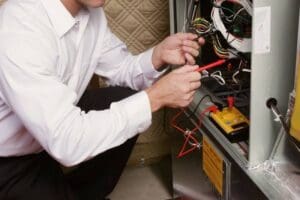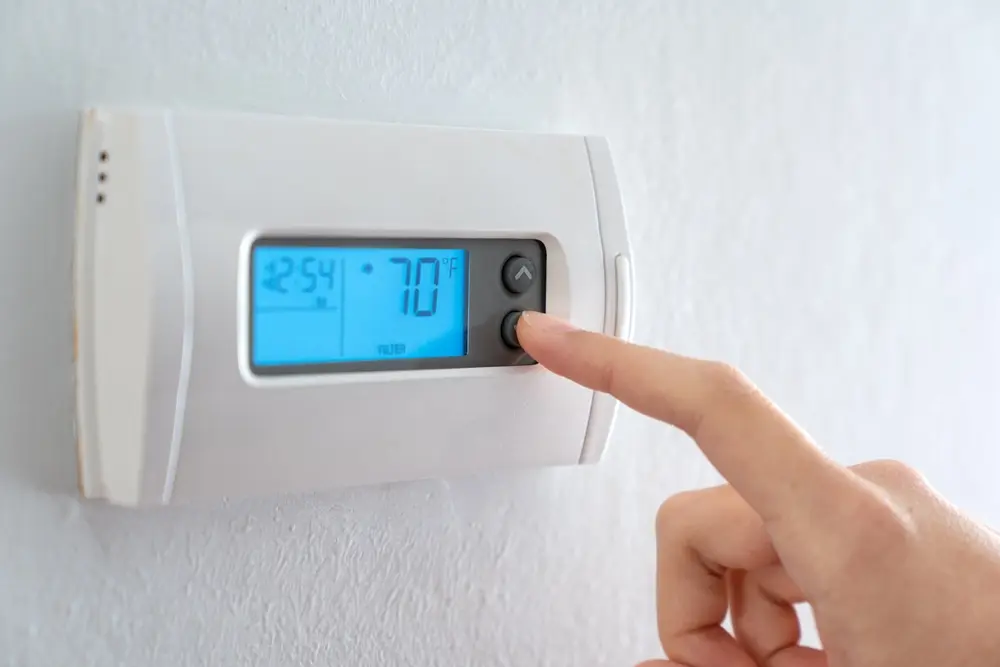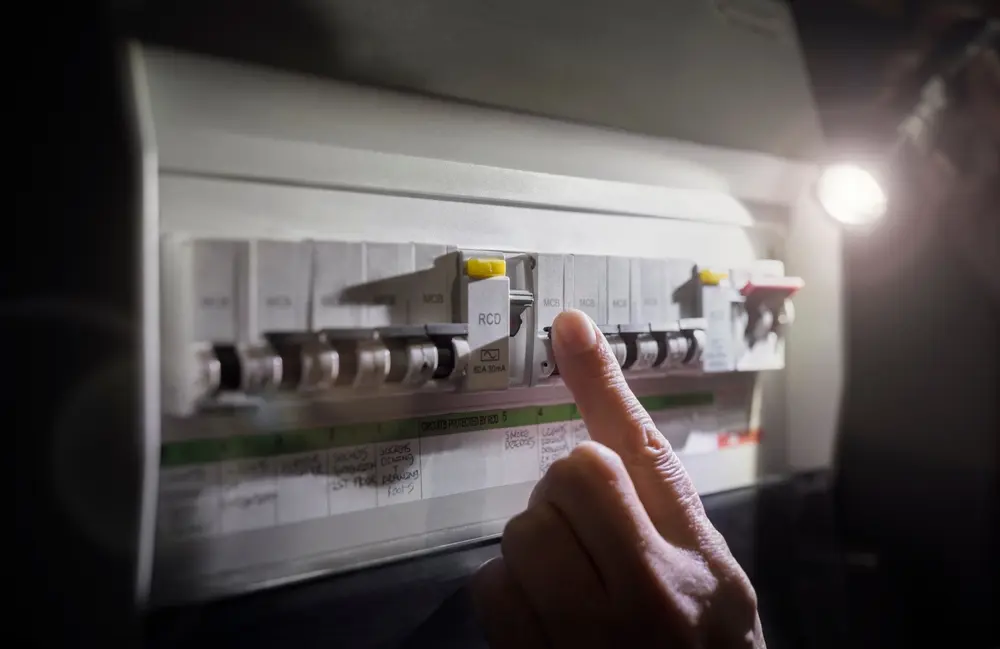Carbon Monoxide & Your Heating and Cooling System: Here What You Should Know

If you think you’re experiencing a carbon monoxide leak in your home, get outside and call 911 for help. Do not try to fix it.
Carbon Monoxide & Your Heating and Cooling (HVAC) System: Here What You Should Know
Carbon Monoxide. We hear about it in headlines all the time. We buy detectors to detect it. And we know that it is very dangerous. However, what is it? What causes it? How bad can it be? How can my Heating and Cooling system create it? And finally, how can I prevent it?
What is Carbon Monoxide, and How is it Created?
Carbon Monoxide is a colorless and odorless gas that can be released into your home when fuel-burning devices are not correctly installed, vented, used, or maintained. Breathing carbon monoxide (CO) can cause carbon monoxide poisoning, which can lead to severe illness or even fatality.
This byproduct harms humans because it hinders the body’s ability to transport oxygen. When we breathe carbon monoxide (CO), it binds to the molecule in our red blood cells that is responsible for carrying oxygen, called Hemoglobin. Once this occurs, it creates carboxyhemoglobin and prevents the oxygen from binding and being transported throughout the body. This will then cause oxygen deprivation and can affect the functionality of vital organs, especially the brain and heart.
What Are the Symptoms of Carbon Monoxide (CO)?
It’s important to note that the initial signs of carbon monoxide (CO) are non-specific and can include the following:
- Dizziness
- Headaches
- Vomiting
- Weakness
- Confusion
- Chest pain
- Loss of consciousness (Elevated-Levels of Carbon Monoxide)
- Death (High-Levels of Carbon Monoxide)
CO exposure can vary; if caught sooner rather than later, you should be fine. However, long-term non-fatal or severe exposure has been shown to cause the following:
- Neurological damage
- Memory problems
- Behavioral changes
Lucky for us, carbon monoxide is only a byproduct of incomplete combustion and can only be released from fuel-burning devices. It’s produced when natural gas, kerosene, propane, and other fossil fuels are burned for home heating or cooking food. And it’s worth noting that small amounts of carbon monoxide are natural and not dangerous to humans.
What Household Items Release Carbon Monoxide?
Believe it or not, the average homeowner’s home is filled with products that create carbon monoxide. These items could include the following:
- Stoves
- Water heaters
- Room heaters
- Fireplaces
- Automobiles
- Lawnmowers and some lawn equipment
- BBQ grills
- Boilers & Furnaces
Yes, Your Furnace Can Produce Carbon Monoxide (CO). Here’s How.
As stated before, carbon monoxide is produced by combustion. With your furnace being a product that uses combustion to heat your home, it too emits carbon monoxide. Nevertheless, if your furnace isn’t correctly installed and isn’t installed by a licensed contractor, CO can disperse into the home. Here are some ways your furnace could be leaking CO:
- Improper installation
- Cracked heat exchanger
- Clogged furnace filters
- A dirty and clogged air filter, over time, will cause the furnace’s heat exchanger to overheat. This eventually leads to the heat exchanger cracking.
- Incorrect furnace sizing
- Improper venting
Luckily, most of the time, if you’re purchasing a new home, your furnace has been installed correctly, and there’s not much to worry about. However, as professionals in the HVAC industry, we see CO leaks more often than the average homeowner would think due to improper installation or poor maintenance.
Does My Air Conditioner Create Carbon Monoxide?
Because your air conditioner doesn’t function using combustion, it does not release carbon monoxide (CO) like fuel burning can. However, if there is a leak in your home, your air conditioning unit can circulate carbon monoxide.
How Can I Reduce Exposure to Carbon Monoxide?
Because we need heat to cook and warm our homes, we can’t entirely eliminate the use of products that cause CO in our homes just yet. However, there are many ways to reduce exposure to carbon monoxide and ensure that we and our families are safe. Here are a few things that we can do:
- Install Carbon Monoxide Detectors. It is best practice to have one carbon monoxide detector installed near your furnace close to the ground. You will also want one in your bedrooms and areas where people hang out.
- Run gas-powered equipment outside. Items such as generators, lawnmowers, and cars should always be run outside of your home – this includes in your garage. Running these items in your garage with the garage door closed allows CO to build up and elevate it to toxic levels.
- Use Gas and Charcoal Grills Outside. When using grills, you want to be in an area with plenty of open air for fumes and smoke to escape. Otherwise, the build-up of smoke and gases can be dangerous.
- Have Your HVAC System Routinely Inspected and Maintained. An annual furnace and air conditioner tune-up is one of the most critical steps to reducing carbon monoxide exposure. Annual tune-ups include a comprehensive inspection of your entire system and ensure that your system doesn’t have any damage and is running as intended. In addition to ensuring your system is running safely and efficiently to avoid exposure to carbon monoxide, it also catches minor issues before they turn into costly repairs.
- Don’t Put Off Repairs. If your furnace requires a repair, don’t put it off. Repair it. Older furnaces and boilers, leaky seams, and cracks in the exhaust piping are potential sources of CO leaks. Not getting these issues fixed could increase the chances of carbon monoxide exposure.
————
Need help preventing carbon monoxide leaks?
Want to prevent carbon monoxide leaks in your HVAC system? Call Randazzo Heating, Cooling, and Electrical at 1-586-209-3885 or schedule an appointment online.
We’ll tune up your HVAC system to ensure it’s running as the manufacturer intended. See why we have over 7,000 5-star reviews and why customers have chosen to go with the name they know.
If you’re interested in our hassle-free Randazzo Air Care maintenance plan to keep your HVAC system operating at peak performance and virtually eliminate your fear of CO leaks caused by your furnace, call us at 1-586-209-3885 or learn more here.
——————–
Recent news link regarding CO: How to avoid carbon monoxide poisoning
***This information does not constitute medical advice or diagnosis. This is strictly informational as it relates to HVAC.***
Request Service

Why Choose Randazzo?
We’re the Name You Know
- Licensed & insured
- Service all brands
- Free estimates on replacement quotes & service calls
- Background-checked technicians
- Financing options
- Lennox Premier Dealer
- Committed to excellence




